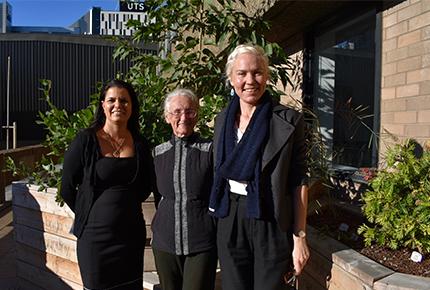Waraburra Nura Indigenous plant garden opens at UTS

The Waraburra Nura Indigenous plant garden
Plant lovers at UTS now have a space on campus to discover the rich history of botanic life in the Sydney basin.
Waraburra Nura (The Happy Wanderer’s Place) is a new Indigenous garden on the north-facing level 6 balcony of the UTS Tower. All its plants are Sydney natives that have existed in the region for thousands of years, adapting to the environment and supporting the people who live here.
While each plant has its own particular traits and uses, the most unique feature of the garden is the relationship between them.
Happy companions
“It’s probably one of the first true associations returned to this area, where plants that help each other to survive have been brought together,” explains botanist and D'harawal Senior Aunty Fran Bodkin. “That means that the maintenance of a garden like this is low because of what they do together naturally. This is recreating what would have been typical here in the Sydney basin all that time ago.”
“The soil is not very important," says Aunty Fran. "You can look upon the soil as an anchor and a provider of certain minerals. But the sustenance the plants get is from each other. That’s why you need these sorts of associations. That’s why, even though Sydney has such poor soils our plants can grow in associations like these.”
When brought together, the leaves of one plant provide nutrients to the soil that are essential to its neighbours. The deliberate grouping of the plants will ensure the vitality and hardiness of the garden.

Mentha Australis in the Waraburraa Nura Indigenous garden
“The plants that are being grown are local to Gadigal and D’harawal countries within the Sydney basin,” says Maree Graham, Deputy Director of the Jumbunna Institute at UTS. Many Jumbunna students and staff have been helping to care for the garden, which sits on the sunny balcony just outside their offices.
“It is so important for us to share this knowledge of the local Indigenous culture that is so richly embedded in the history of Sydney. This knowledge is not widely known amongst many mainstream Sydneysiders and the garden plays an important role in telling that story.”
A shared experience

Maree Graham, Aunty Fran Bodkin and Alice McAuliffe
The creation of the garden has been a true collaboration, with Jumbunna providing essential funding and UTS Facilities Management Operations managing the project. Aunty Fran shared stories and knowledge about the uses of each plant – about which more can be found at the garden’s website – while Yamatji Wajarri woman Nicole Monks, of Black and White Creative, designed the garden boxes, using chlorophyll cells as an inspiration.
The project was driven by Alice McAuliffe, UTS ART Coordinator Learning and Projects.
“I was at a conference where I heard about an Indigenous garden at a university in Perth that was providing a space for people to visit and learn about species native to that region,” says Alice. “It sparked the idea of creating a similar space here at UTS.”
The project hit a few small snags when consultant botanist Aunty Fran gave Alice a list of Sydney natives to find.
“Most of the plants in the garden were extremely difficult to track down. It’s concerning that these plants that have been actively cultivated to grow here for thousands of years, to support each other and the communities around them, are no longer commonly found,” says Alice. “I’m hoping visitors to the garden will take note of the plants and ask for them at local native nurseries and in time they will become more common again.”
And advice for any wannabe native gardeners who want to try this at home?
“When growing these plants the main thing to remember is that they grow better in a cluster of natives than alone and Eucalypt leaves need to be mixed into the soil,” Alice advises. “It can be poor soil and your watering habits can be terrible, but the natives will still thrive in companion with Eucalypts.”
Alice's efforts to establish the garden have been recognised with a UTS Green Hero Award, while the garden has been awarded $10,000 from the James Kirby foundation for an education program that will target Galuwa Experience students and local community groups, as well as the UTS community.
Students, staff and visitors to UTS are all welcome to visit Waraburra Nura, to learn about Sydney’s botanical history, water the garden with the watering cans provided, pick a Eucalypt and smell the vapours or just sit and relax.
